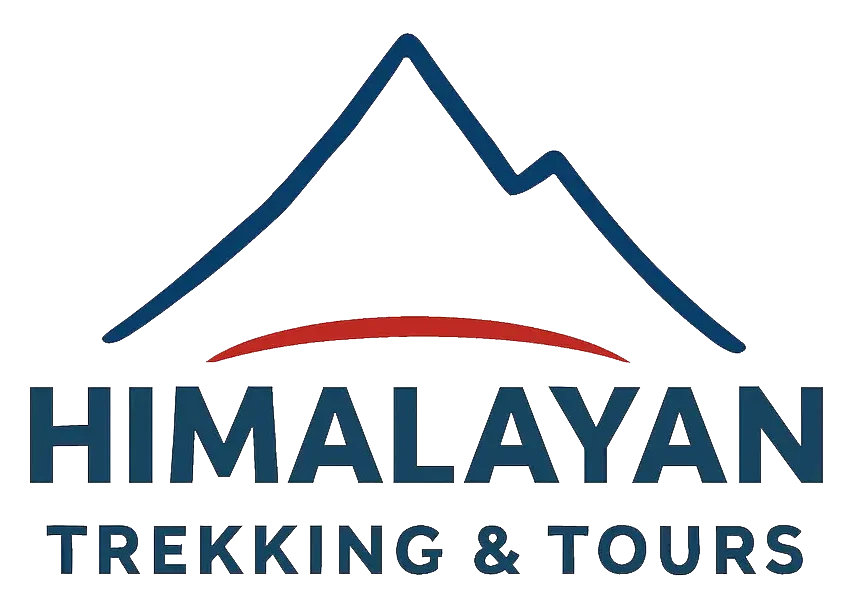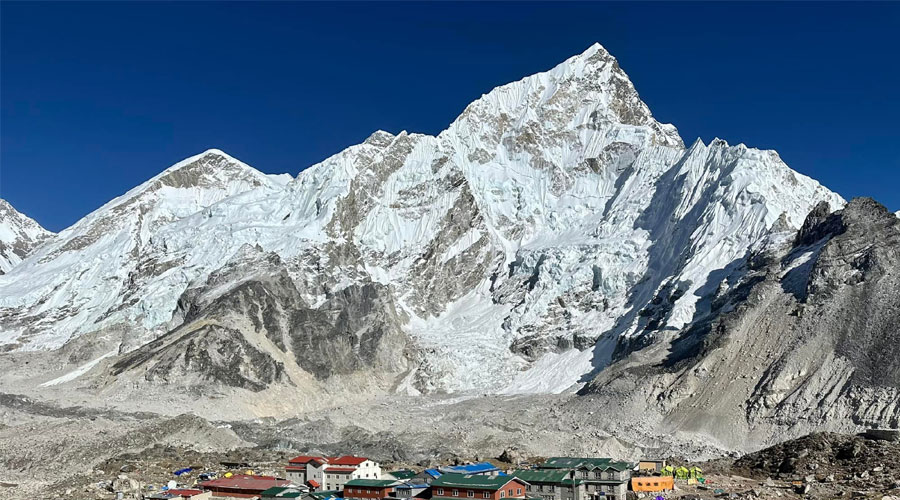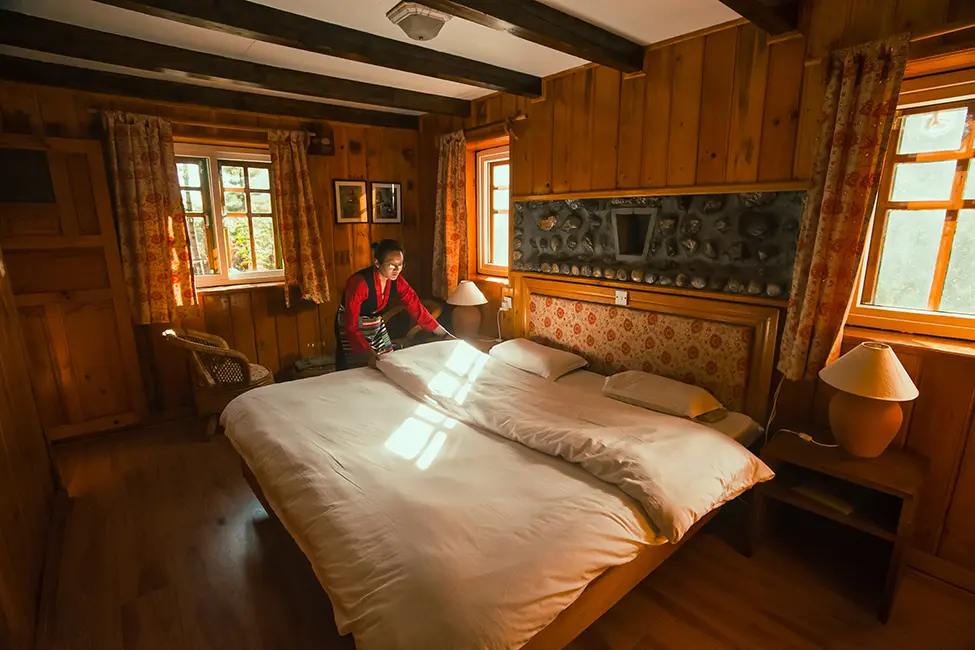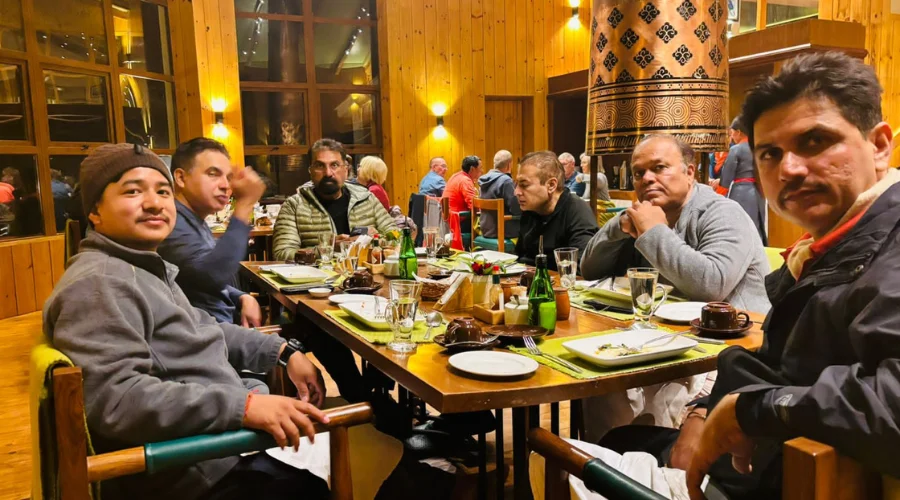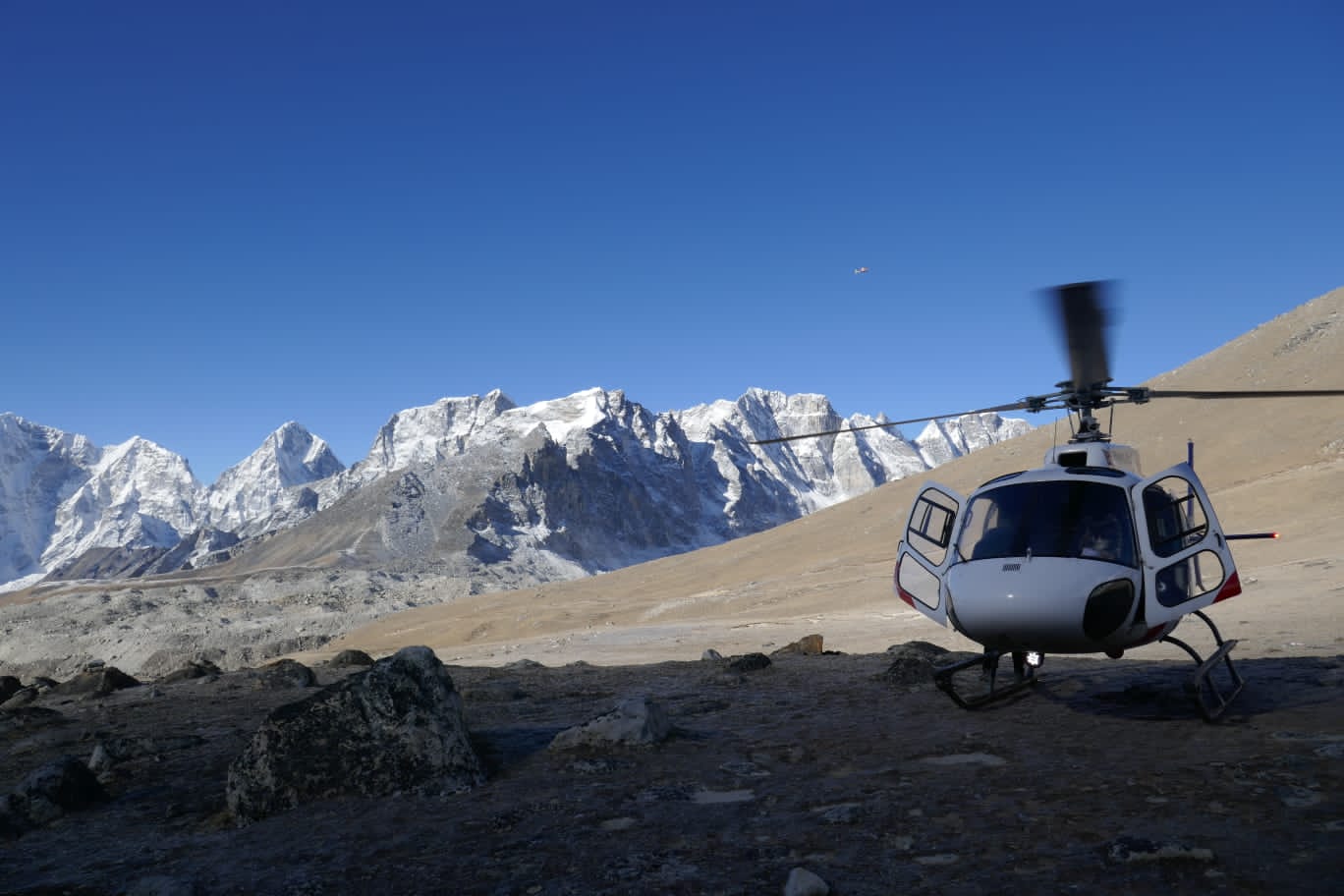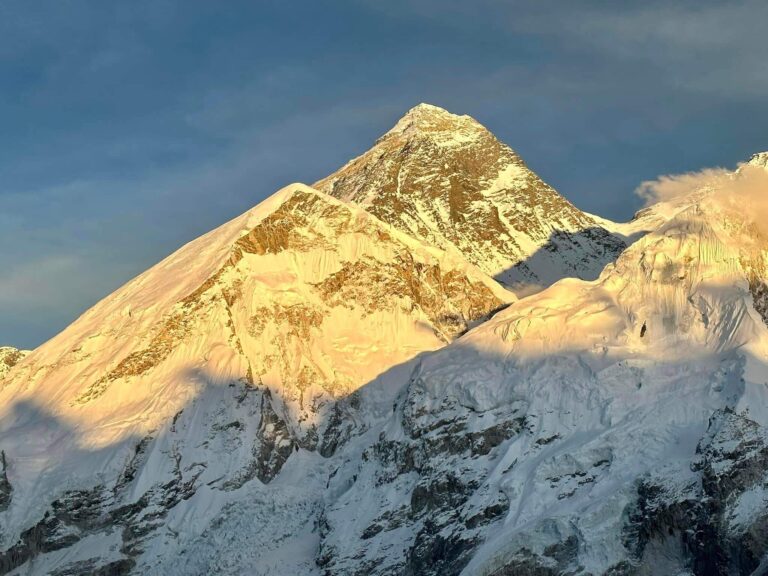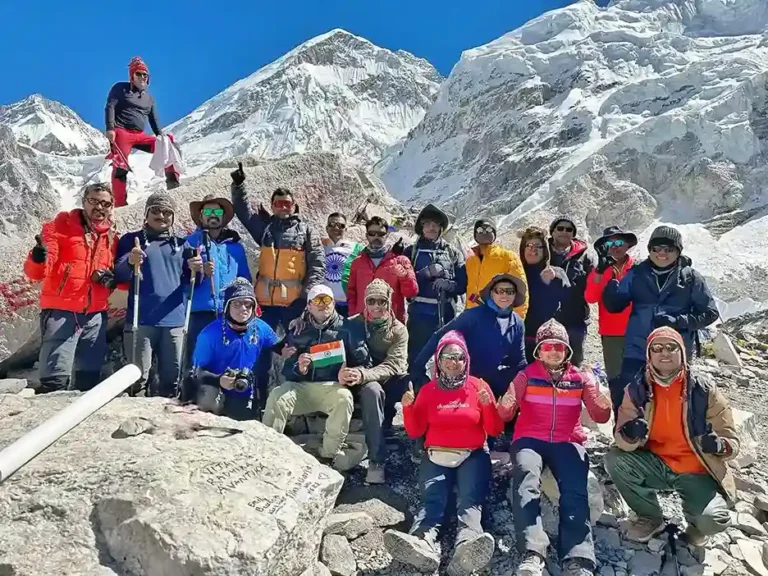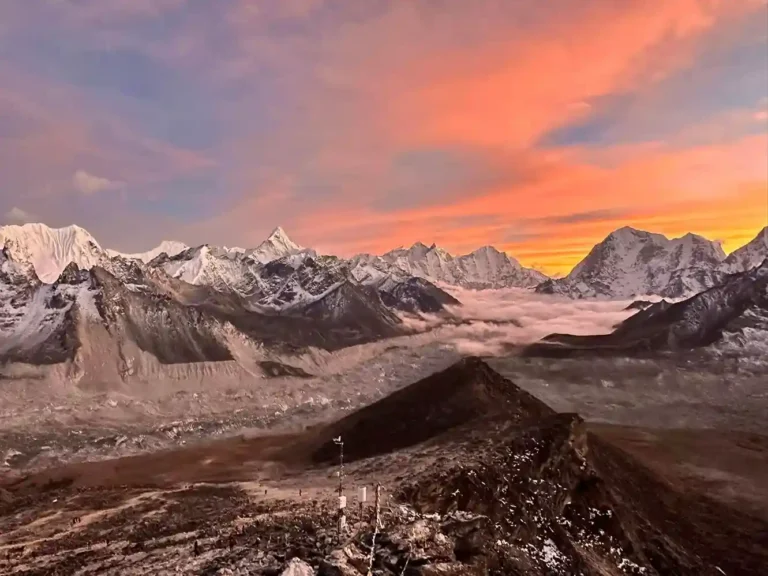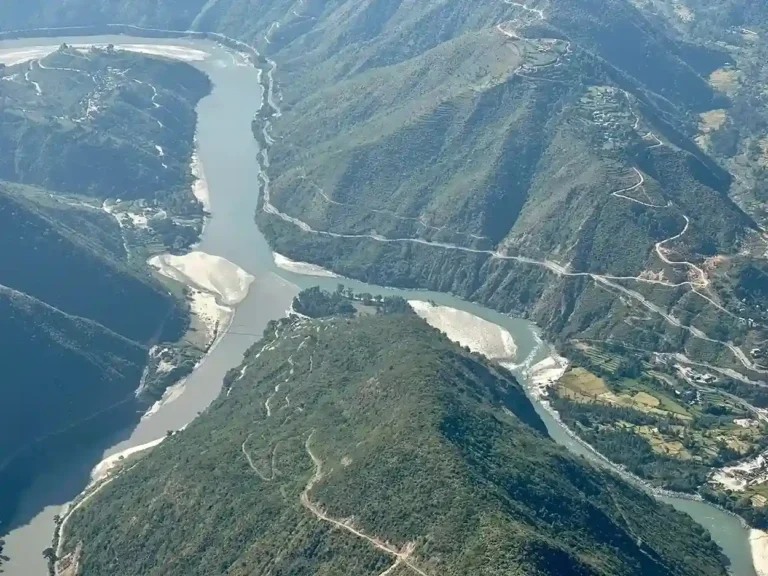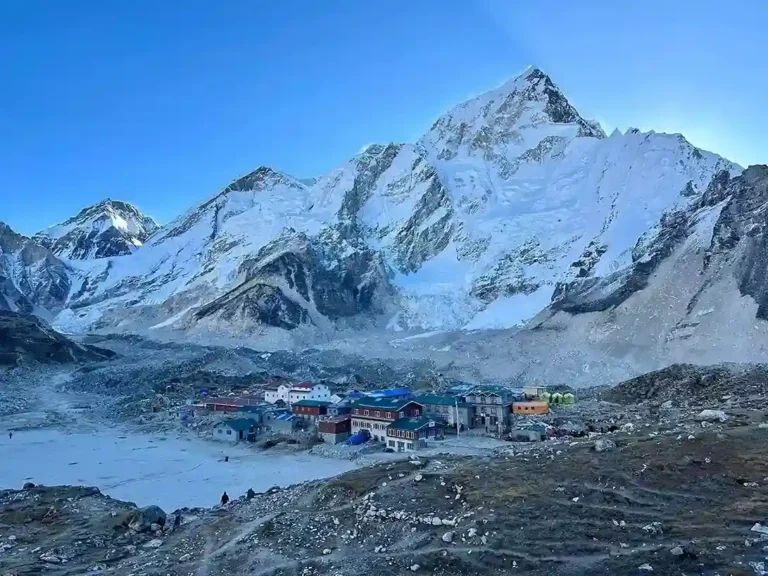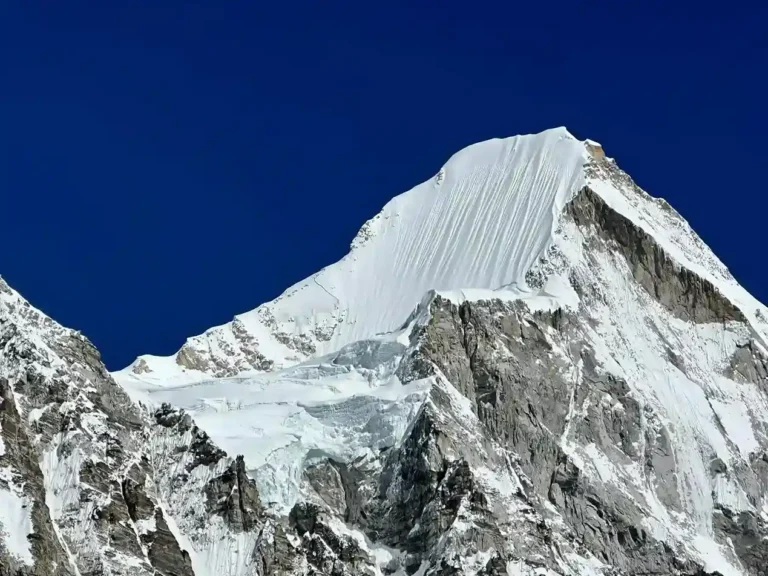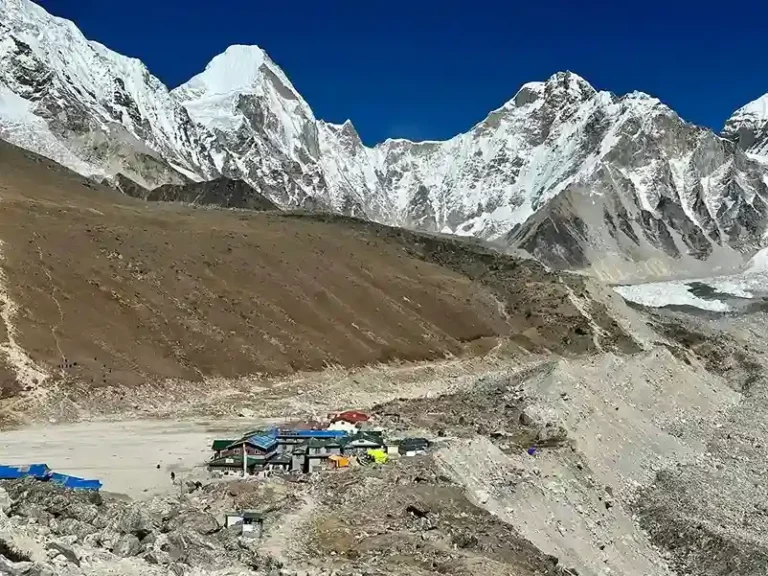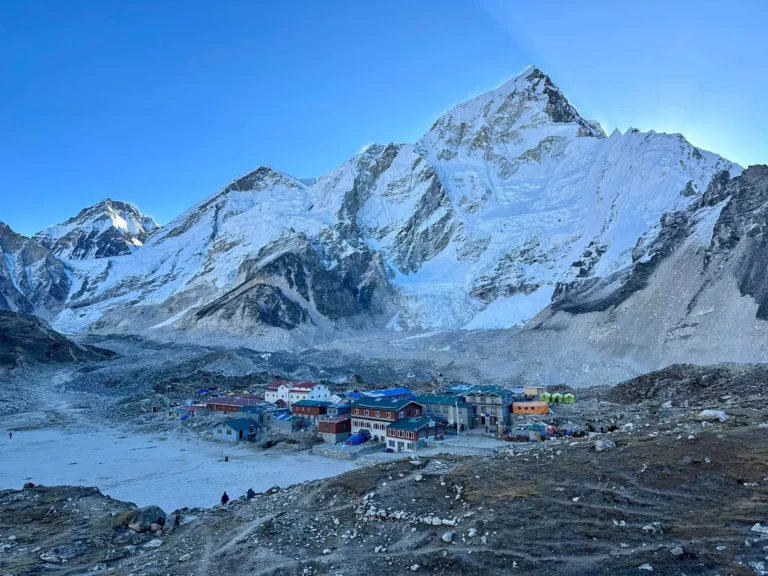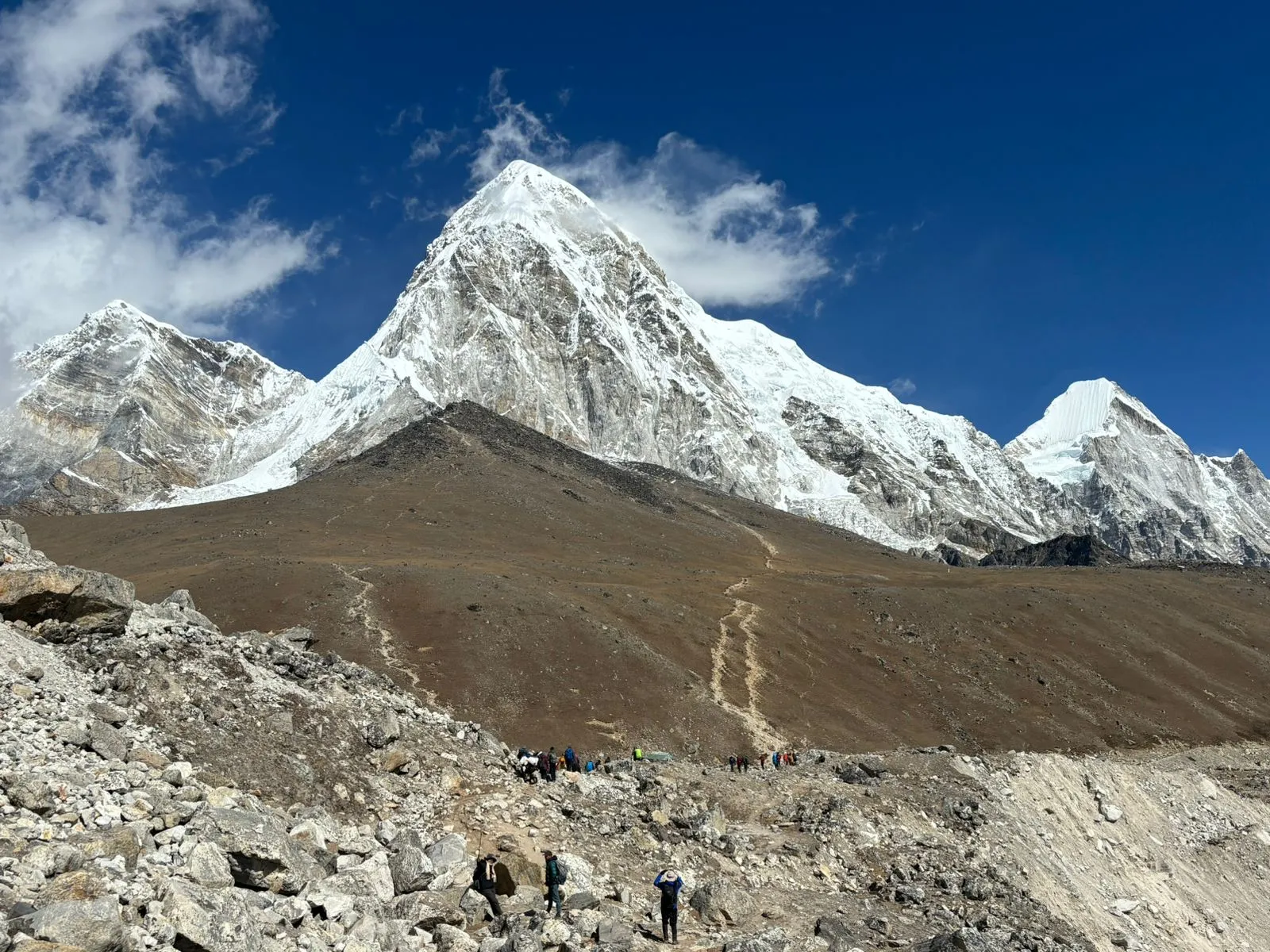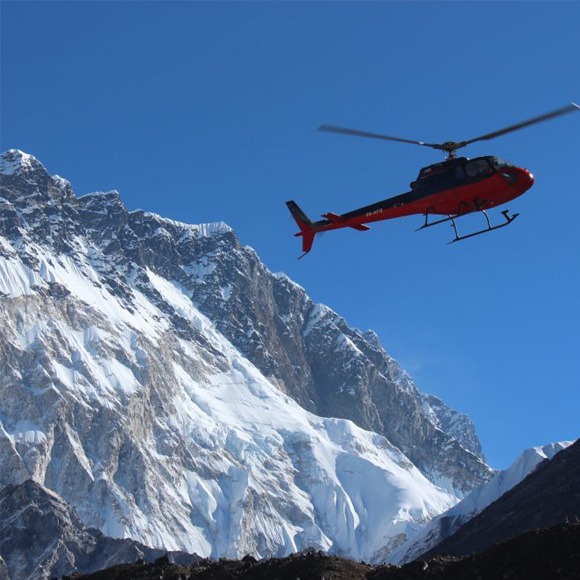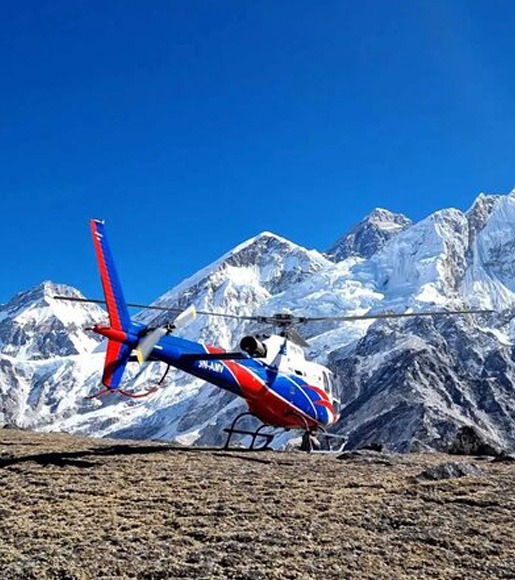Luxury Everest Base Camp Trek
-

Trip Duration 11 Days
-

Max, Altitude 5545m
-

Type Luxury
-

Best Season Sept-May
-

Meals All Meal Included
-

Accommodation Luxury
-

Activity Hiking & Trekking
-

Difficulty Strenuous
- Scenic views of Mountain ranges such as Mt. Everest, Mt. Pumori, Mt. Lhotse, Mt. Ama Dablam, and so on.
- Stay with Comfort hotels with delicious Meals.
- Pass through Sagarmatha National Park and Imja River on the way.
- Tenzin Hillary Bridge, suspension bridge, and Tenzin Hillary airport.
- Spectacular mountain flight to Lukla.
- Helicopter ride for the best view of the top of the world.
- Walking on the same path as the first man to summit Everest.
- It is the most luxurious among several Everest trekking packages.
- Trek with our highly experienced guides and professional team.
Luxury Everest Base Camp Trek is the finest adventure to the world’s highest mountain, complementing luxury and royal comfort.
Luxury Everest Base Camp Trek is a unique opening for people who want pleasure from the ordinary trek and take luxury out-of-the-ordinary adventures in the Himalayas.
Luxury Everest Base Camp Trek Overview
As soon as you move to the Everest region, everything around you feels specifically designed for comfort—accommodation in comfortable lodges and teahouses with luxury rooms, hot showers, heaters and scenic mountains.
Try delicious meals in the restaurant, cooked with great attention to detail, where local and world cuisine themes are successfully intertwined to feed your vigour and indulgence.
Discover beautiful Sherpa country and its aging monasteries, valleys inhabited by colourful birds and wildlife, and snowcapped peaks in the background.
During the Everest Base Camp Luxury Trek, you will appreciate the great attention of Tour Guides and Porters, who will make your Luxury Everest Base Camp Trek smooth, secure, and unforgettable.
It is not just a walk but a royal stroll through the Himalayan range. If you want to trek along Everest and experience the beauty of the mountains without compromising on luxury, this trek is just right for you.
Experience the world of natural elegance and comfort—your dream of reaching Everest Base Camp will come true!
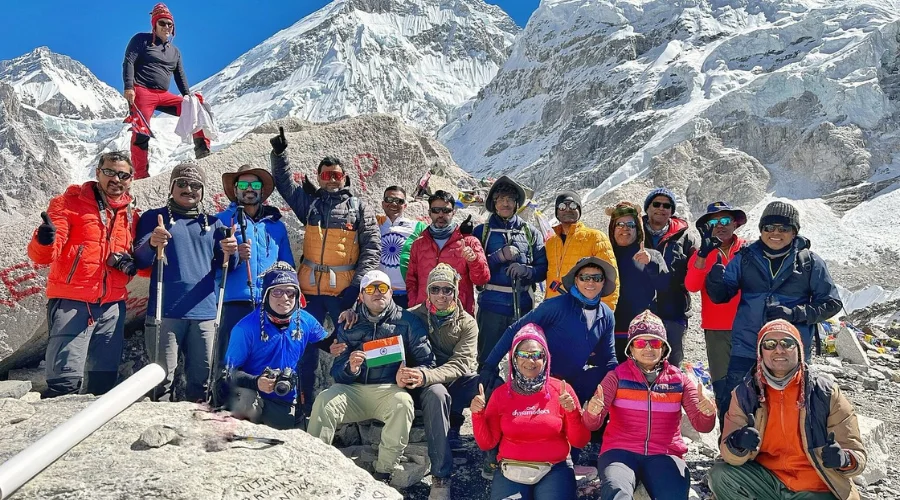
Luxury Everest Base Camp Trek Difficulty
The Everest Base Camp (EBC) trek is memorable, but one should be mentally and physically prepared. Some challenges include high altitude, steep terrain, and long days on the trail.
From Lukla, at an elevation of 2860 m, to EBC, at an altitude of 5364 m, trekkers face steep climbs, descents, and shallow, sharp edges. They complete the trek mostly along narrow paths, some of which are rocky or rugged.
The most common problem is altitude sickness. As people climb higher up the mountain and above sea level, the air is less to breathe. Acclimatising is essential, and most tours require at least one day’s rest to reduce the effects.
The Luxury Everest Base Camp Trek difficulty is challenging regarding physical fitness, endurance, and stamina. Trekking experience is practical but not compulsory for this trek.
Although trekkers walk an average of 5 to 7 hours daily for 12 to 14 days, the walks may be strenuous.
Altitude Sickness
The most significant risk is developing acute mountain sickness (AMS) symptoms, which are hardly rare on the trek to EBC. This condition occurs when the cardiovascular system is stressed by low oxygen levels at high altitudes.
They occur when travelling to higher altitudes above 2,500 meters. Common signs are headaches, nausea, dizziness, fatigue, shortness of breath, and insomnia.
The elevation at the Everest Base Camp reaches 5,364 m, up from 2,860 m in Lukla. Hence, acclimatisation is necessary.
To minimise the risk, trekkers ascend slowly and spend many days at Namche Bazaar at 3,440m and Dingboche at 4,410m. Drinking water only, avoiding alcohol consumption and walking, jogging or running at a steady pace.
Another category includes HAPE and HACE, which can become fatal if left untreated. Such sickness requires the patient to descend immediately and seek medical attention.
If necessary precautions are taken, most trekkers on this Everest Luxury Trek can complete the whole journey safely and happily amidst the fantastic views of the Himalayas.
Short Itinerary
Itinerary of Luxury Everest Base Camp Trek
As the adventure begins, guests are warmly welcomed by Himalayan Trekking and Tours our vibrant capital city, Kathmandu, the gateway to the majestic Himalayas. Upon arrival, our dedicated representative ensures a smooth transfer to a luxurious hotel, where every comfort awaits.
Our hotel provides a haven of tranquility, providing comfortable amenities for resting and recovering from your tiring journey before starting the trek. Meals are included, allowing trekkers to savor Nepali cuisine and local flavors, tantalizing the taste buds with authentic local dishes.
As evening descends, trekkers gather for a comprehensive briefing. This will ensure you are well-informed and prepared for the adventure of the EBC. With meticulous attention to detail, every aspect of the journey is planned, ensuring guests are well-prepared and eager for the adventures that lie ahead.
Hence, full of excitement and anticipation, the first day concludes with a sense of anticipation and wonder, for an unforgettable trek lies ahead.
- Hotel Marriott Kathmandu
- Dinner Included
Today, you will get to explore the vibrant culture of Kathmandu. The morning after breakfast will be dedicated to the highlights of Kathmandu. You will visit the UNESCO World Heritage Sites in Kathmandu. We begin with Swayambhunath, known as the Monkey Temple, where ancient stupas and playful monkeys coexist.
We then head to Pashupatinath, a sacred Hindu temple by the Bagmati River, offering insights into Hindu rituals and traditions. Then we march to Boudhanath, one of Nepal’s largest stupas, surrounded by a peaceful ambiance.
In the evening, meet your trekking guide for an informative briefing on the upcoming journey. Enjoy some free time for any last-minute shopping or personal preparations before we start our adventure to EBC.
- Hotel Marriott Kathmandu
- Breakfast, Lunch and Dinner Included
An early morning Helicopter flight, usually around 6 a.m., takes you to Lukla. Lukla is a small town in the Khumbu Pasanglhamu rural municipality. It is home to the legendary Tenzing-Hillary Airport. Known for its thrilling runway, it’s an experience you won’t forget- in one of the most dangerous airports in the world due to its short runway. The thrill of reaching here is another level of adventure.
Once in Lukla, begin your trek towards Phakding, a nice, small village along the Dudh Koshi River, just north of Lukla and south of Monjo, at an altitude of 2,610 meters. With its scenic beauty, Phakding sets the perfect tone for the adventures ahead. Explore the breathtaking landscapes as you trek, and get ready for an unforgettable journey.
- Yeti Home- Phakding
- Breakfast, Lunch and Dinner Included
After breakfast, we begin our journey by following the trail alongside the Dudh Koshi River, crossing suspension bridges along the way. As we hike, we enter Sagarmatha National Park and go through entry permit verification for the Everest region. This day scenic trek covers around 10-11 kilometers, offering stunning views and a chance to acclimatize to the altitude.
On the uphill climb to Namche Bazaar, be prepared for your first captivating views of Everest and its neighboring peaks (if the weather is clear).
Namche Bazaar is a bustling Sherpa town nestled in the heart of the Khumbu region. Here, you are surrounded by the warmth of the local culture.
- Yeti Home- Namche
- Breakfast, Lunch and Dinner Included
Day 5 is all about taking a breather and letting our bodies get used to the altitude in Namche Bazaar. No rush, no steep climbs—just a day to relax. You can wander around this lively Sherpa town, explore the region, and enjoy the local vibes. It is not just a trading center, but a vibrant hub where you can find everything from trekking gear to unique local handicrafts and souvenirs.
Take it slow, enjoy the views, and maybe strike up a chat with some locals to get to know the way of life there. Namche Bazaar has this cool mix of tradition and modernity, so you might stumble upon a cozy teahouse or a shop with handmade treasures.
We will also visit the Sherpa Cultural Museum to learn the fascinating history and culture of the Sherpa community, gaining valuable insights along the way.
But the adventure doesn’t stop there. We will hike up to Syanboche Airport, the highest airport in Nepal, and Hotel Everest View, which holds the title of the highest hotel on the planet. From these lofty vantage points, prepare to fall in love by the breathtaking vistas of Everest, Ama Dablam, Lhotse, Nuptse, and more.
Just remember, today is about acclimatizing—getting in sync with the altitude and gearing up for the higher adventures waiting for us. So, take a deep breath, enjoy the day, and get ready for the epic journey ahead.
- Yeti Home- Namche
- Breakfast, Lunch and Dinner Included
As the sun rises and hits the mountain peaks, the golden hues of morning light, will captivate your soul. Thereafter, you start on a captivating journey on this very 6th day, trekking towards the cultural gem of Tengboche. The trail goes through dense rhododendron forests (as lovely as it looks during spring), which look just marvelous! It will create an amazing setting for the entire Khumbu region.
Along the way, the air is filled with the melodious calls of Himalayan birds—a melodic touch to your trek, indeed! With the rocky path, the route descends early in the day and then climbs up to Tengboche.
Arriving at Tengboche, the sacred Tengboche Monastery is seen along with the snow-capped peaks, creating a moment of spiritual reflection in the middle of the breathtaking Himalayan panorama.
- Rivendell Lodge
- Breakfast, Lunch and Dinner Included
The 7th day of your journey, after a restful night in Tengboche, we march for Dingboche in the morninge, at an altitude of 4,410 meters. The trek to Dingboche usually takes about 5–6 hours from Tengboche.
The trek takes us through amazing alpine forests as we make our way to Deboche, crossing the Imja Khola via a suspension bridge along the route. On the way, we will see a wall inscribed with stones, adding to the charm of the raw landscape.
As the day goes on, we’re greeted with breathtaking views of the majestic Ama Dablam, sure to leave you spellbound. We finally arrive at Dingboche village after a rewarding ascent.
- Hotel Bright Star or Similar
- Breakfast, Lunch and Dinner Included
The day’s trek not only brings you closer to your ultimate destination but also allows for acclimatization, a very important aspect of the journey. Dingboche serves as an ideal location after Namche for resting and rejuvenating.
Adapting to the higher altitude and changing environment is important to avoid altitude sickness. Today, we acclimate by hiking to Nangkartsang Peak, where the breathtaking view of Ama Dablam again awaits. After the acclimatization hike, take the opportunity to explore the village or snuggle inside the cozy teahouse.
The 8th day gives you the opportunity to learn about the local Sherpa community, whose hospitality adds cultural richness to the Himalayan adventure in Nepal. As the sun sets over the towering peaks, casting hues of orange and pink across the sky, Dingboche becomes a haven, offering a well-deserved respite before continuing your ascent towards Everest Base Camp.
- Bright Star or Similar
- Breakfast, Lunch and Dinner Included
Beginning on Day 9, your trek to Lobuche brings a captivating shift in scenery by hiking a gentle climb to Thukla. You’ll be amazed by the breathtaking views of Taboche and Cholatse.
Lobuche, your destination for the day, is situated in a dramatic landscape, offering beautiful views of the Khumbu Icefall. The sense of anticipation builds as you approach this high-altitude haven.
The evening presents an opportunity to reflect on the day’s journey, surrounded by the towering peaks of Nuptse, Lobuche, and Pumori towering above the village.
- Altitude Oxygen
- Breakfast, Lunch and Dinner Included
Day 10 marks an important moment in your trek. Today’s trek consists of two sections. Firstly, we follow the trail to Gorak Shep, and then continue on to Everest Base Camp. Gorak Shep is a small village located in the Khumbu region of Nepal, at an altitude of 5,164 meters. Gorak Shep is the last stop on the trek to Everest Base Camp before reaching the foot of the world’s tallest mountain. The trek to Gorak Shep usually takes about 5–6 hours from Lobuche, depending on the route we take.
Continuing the trek to Everest Base Camp itself, the trail ahead presents challenges with rugged terrain. Along the way, you will come across captivating views of the Khumbu Glacier and Khumbu Icefall. Thereafter, you arrive at the much-awaited Everest Base Camp.
At this very moment, you will be standing at the very foundation of historic expeditions—the gateway to the highest point on Earth. In the thin mountain air, the sense of accomplishment is felt at a deeper level.
Thereafter, we can take a higher route to get a glimpse of the Khumbu icefall and the route to the South Col. We then return to Gorakshep for a night.
- Everest Inn or Similar
- Breakfast, Lunch and Dinner Included
Rise with the first light of dawn on Day 11 as we begin an exciting early morning hike to Kala Patthar.
Kala Patthar is a famous landmark located on the south ridge of Pumori, above Gorak Shep. It offers a perfect view of the spectacle of the sun casting its golden hues upon the mighty Everest and its neighboring peaks.
It is an excellent vantage point for the incredible view of Lhotse, Nuptse, Pumori, and Mount Everest. After relishing this unforgettable sunrise experience, we make our way back to Gorak Shep for a hearty breakfast, preparing for the next phase of our adventure.
Following breakfast, a thrilling helicopter journey awaits to transport us back to Kathmandu. This aerial expedition not only provides a swift return but also provides a mesmerizing 360-degree bird’s-eye view of the diverse Nepalese terrain.
Please kindly note that the operation of flights is solely dependent on the airline and may be influenced by the volume of travelers during a specific month.
- Hotel Marriott Kathmandu
- Breakfast, Lunch and Dinner Included
This day, our guide will pick you up from the hotel and transfer you to airport for your onward journey or back to home.
Price includes
- Kathmandu Airport – Hotel – Airport transfer by Private vehicle
- Three Meals (Breakfast, Lunch and Dinner) during the trek
- Plenty of Tea and Coffee during the trek
- Twin Sharing Accommodation at Kathmandu Marriott for 3 nights with breakfast
- Twin sharing accommodation at Luxury Lodges (Yeti Mountain Homes) for 3 nights at Phakding and Namche Bazar
- Twin-sharing accommodation at teahouses/lodge after Namche for 5 nights
- National Park Entry Fee, Local Government Entry fee
- Helicopter Flight to Lukla from Kathmandu
- Gorekshep to Kathmandu helicopter flight
- 1 Experienced guide for the group of 2 to 10 and assistant guide for a group above 10
- One porter assigned for two people to carry luggage
- Our Staff’s daily meal, wage, equipment, insurance and allowances
- Sightseeing in Kathmandu valley covering best places inclusive of guide, car and entrance fees
- First aid kit with high-altitude medicines
- Supplementary oxygen for emergency purposes on the trek
- Duffel bag and Sleeping bag (Must be returned after completion of the trek)
- Trek completion certificate (Upon request)
- Our Service Charges
Price Excludes
- International airfare, Nepal Visa and travel insurance
- Meals in Kathmandu except breakfast
- Extra night accommodation in Kathmandu ( early arrival or flight cancellation etc)
- Personal expenses
- Gratuities for staff
Have any Questions? Check out FAQ'S
Trip Essential Information
Food During the Luxury Everest Base Camp Trek
The Luxury Everest Base Camp Trek involves trekkers having various nutritious meals to cater for the trekkers’ energy requirements and improve the trek’s experience.
All the food is cooked fresh, and meals at the lodges and teahouses on this circuit are served in more hygienic and somewhat upscale conditions than standard treks.
These may include fresh bread, pancakes, eggs, porridge, muesli, seasonal fruits, coffee, tea, or juice.
Breakfast is served, while lunches and dinners are local and international. Dal Bhat, a typical Nepali soup made from lentils, rice, vegetables, or meat, is an exceptional regional dish.
Momo is a Nepali steamed dumpling filled with chicken or vegetables. Curries are also available. Western meals, such as pasta, pizza, soups, and grilled dishes, are also options.
Such lodging facilities offer food freshly prepared and of better quality than hotel-prepared meals, probably because the meals are properly cooked to prevent food poisoning.
Some lodges also provide a menu, baked products on arrival and a choice of beverages.
Many high-altitude diets are carbohydrate-based to maintain energy, so expect lots of rice, noodles and potatoes. Drink water is primarily clean, having been filtered or boiled in some cases.
Accommodation In Luxury Everest Base Camp Trekking
Luxury Everest Base Camp Trek provides refined and comfortable services compared to regular treks, as all our accommodations shall be in luxurious hotels.
From our arrival in Kathmandu, our tour plan includes only the best-quality hotels, with comfy rooms, baths, hot water, wireless facilities, and top-notch dining experiences.
Along the VIP Everest Trek are recognized luxurious guest houses suggested by Yeti Mountain Homes and Everest Summit Lodges services.
It provides tidy, clean rooms with heated blankets that will unbelievably warm you up, washrooms, hot water, and sometimes heaters if the weather is freezing.
The lodges are built to provide the comforts of the 21st century while retaining the flavour of the Himalayas. After days of strenuous trekking, such services feel like heaven.
In more remote locations like Dingboche or Lobuche, where the facilities are less lavish than in Lukla, luxury teahouses offer superior services compared with simple lodges. These include better bedding and carefully cleaned kitchen and dining areas.
Everest luxury treks combine comfort, hospitality, and incredible mountain views. They keep clients fit and well-rested for the next day’s activities.
A Typical Day On Luxury Everest Base Camp Trek
On the Luxury Everest Base Camp Trek, your day begins with tea or coffee in your room before breakfast.
After a filling breakfast in the lodge’s dining room, you will brace yourself for a walk, which will take between 4 and 6 hours, depending on the level of activities planned for the particular day.
This trekking offers close-up views of several interesting peaks, majestic valleys, and interesting sherpa settlements.
During the trek, you will be given short breaks to take photographs, refresh, and hydrate. Lunch is served at the scenic lodge, and nutritious food is served.
In the afternoon, shorter day hikes or trips to the day’s target destination usually occur. Upon arrival at a luxury lodge, one is welcomed and eased in with warm towels and refreshments.
Night involves visiting comfortable living rooms, taking hot showers and eating nice hearty meals.
Optional activities in the evening include reading, playing board games, or even conducting stargazing before heading back to the comfortable, heated room for their night’s rest.
Packing List for Luxury Everest Base Camp Trek
Though luxury trekking may involve the availability of many facilities, it’s essential to pack appropriately as the journey is at a high altitude. Here’s a comprehensive list:
Clothing
- Base Layers
- Insulating Layers
- Outer Layers
- Trekking Pants
- T-shirts
- Warm Gloves
- Hats
- Socks
- Gaiters
Footwear
- Waterproof trekking boots (sturdy).
- Lightweight sandals or sneakers for evenings.
Accessories
- Trekking poles.
- Sunglasses with UV protection.
- Buff or scarf for dust and cold.
Personal Items
- Water bottles or hydration system.
- Sunscreen, lip balm, and moisturizer.
- Basic toiletries and wet wipes.
- First aid kit (including altitude sickness medication).
- Snacks like energy bars.
Electronics
- Headlamp with extra batteries.
- Power bank and chargers.
- Camera (optional).
Permits for Luxury Everest Base Camp Trek
There are particular Everest permits that every trekker requires to participate in the Everest Base Camp Trek.
Sagarmatha National Park Entry Permit is needed to cover the Everest Base Camp area. The cost is NPR 3000 for Foreign Nationals per head, excluding VAT.
This permit can be issued at the Nepal Tourism Board in Kathmandu or at the Park’s entry point in Monjo.
The Khumbu Pasang Lhamu Rural Municipality Permit costs NPR 3,000 per person. This permit should buy at Lukla.
If approaching through the Jiri, the Gaurishankar Conservation Area Permit is necessary. It costs NPR 3000 per person, and the Nepal Tourism Board office is in Kathmandu.
Permits are checked at multiple points along the trail, so trekkers must carry copies of their passports and a few passport-size photos for processing. Luxury trek providers like us help get these permits to simplify the process.
Travel Insurance for Everest Luxury Trek
Medical travel insurance is crucial for the Everest Base Camp trek. Trekking at high altitudes exposes some individuals to various dangers, and accidents can sometimes occur.
It should include coverage up to 6000m and helicopter rescue for high-altitude sickness, injuries, medical emergencies, trip cancellations, and delays.
This location and conditions make evacuation very expensive, so insurance is essential. Select a policy from a reputed insurance company with a clearly stated trekking policy.
Remember to include lost baggage and personal belongings in the insurance list. During the trek, obtaining a soft copy and a hard copy of the insurance policy for verification is also wise.
Tipping Culture in Everest Luxury Trek with Helicopter Return
Tipping is a general tradition in the Everest region. It rewards the effort of guides, porters, and staff who make the trek more secure and enjoyable. Tipping is not mandatory; it’s a way to thank the staff for their work.
Typically, during the trekking excursion, trekkers contribute or collectively pay tips at the end of the trek.
The recommendations for the guide are $10-$15 per day, and for porters, $5-$10 per day, depending on the quality of the service and the number of days of the trek. Of course, more prominent groups tip somewhat more.
Most of the time, tipping is done in Nepali rupees during the trip meeting or the farewell dinner. Anything that one does in a tip manner is well said in words. Finally, ensure that the tip is somewhat shared if you hire more than one porter.
Please always consider that tipping indicates your satisfaction with the services, and it helps twofold: the members involved in your trek and you.
Everest Luxury Base Camp Trek Cost
The Everest Luxury Base Camp Trek costs $ 3880 per person. It still depends on trail, time of year and luxury. This EBC Luxury trek cost usually covers transportation in comfortable and luxury vehicles, meals in standard restaurants and hotels and luxurious lodgings and teahouses on the trekking trail.
Food accommodation includes daily nutritious meals: snacks, tea, and coffee breaks.
The service includes air tickets to Namche Bazaar and Lukla, airport transfers, necessary permits, a Sagarmatha National Park Permit, and a Khumbu Pasang Lhamu Rural Municipality Permit.
Further, the cost includes a guide and porter with insurance and additional services such as hot showers, Wi-Fi, and charging when available.
However, the price excludes travel insurance, personal expenses, porterage tips for the guides and porters, and international airfare.
Although slightly more expensive than traditional treks, the luxury trek guarantees a royal treat with added luxury and professional services.
Best Time for Luxury Everest Base Camp Trek
The best time for Luxury Everest Base Camp Trek is from March to May and September to November, with favourable weather, a clear atmosphere, and good-natured trekking parameters.
Spring brings the claws of various wildflowers, especially red and pink colours, from the blooming rhododendrons at the trail area.
The daytime is warm, and Everest temperatures occasionally range between 5 and 15 degrees Celsius; at higher altitudes, they can reach -10 degrees Celsius.
This season is the best month to explore Everest and other peaks because everything is clear, and there is no atmospheric haze to spoil the snapshot.
Autumn comes after the monsoon; the climate is generally dry, and the sky is clear during this season. It experiences a cool and dry environment, with the lowland area experiencing temperatures between -5 °C and 20°C, but as one goes up, the highland’s temperatures drop.
The climate is crisp, and the vistas are beautiful, generating excellent conditions for a high-class service during treks and luxury accommodations in lodges.
Other seasons include winter, from December to February, and monsoon, from June to August. Though the trek can be done during these periods, cold, snow, and rain make it more challenging.
Only during the spring and autumn seasons can the trek to EBC be as fun and comfortable as possible.
Drinking Water
Water is crucial but time-consuming during the Everest Base Camp trek, so it must be managed carefully and safely.
Although water is often accessible from streams and taps, it is often unsafe to use directly as water is highly likely to be contaminated.
Water must be boiled, filtered, or treated with water purification tablets. Most lodges offer treated water at a small charge. Alternatively, you can carry a water purification system for your convenience.
You can get a water purification system if you prefer not to drink water. While water is provided in bottles, this is costly and contributes to plastic waste; hence, people are advised to carry their bottles.
Drinking water prevents dehydration, especially at higher altitudes.
Wi-Fi on EBC Trek
The internet is accessible in most of the teahouses on the EBC trek, but the connection is extremely slow and costly.
The quality declines as you go to the upper levels, but connectivity is superior in the lower villages. However, it is still better than the mobile network coverage.
Electricity During Everest Luxury Trek
Solar or sometimes small hydropower provides electricity in most teahouses but is limited at higher altitudes.
Charging devices costs between NPR 200 and 500 per device. It is recommended that an additional battery pack be taken in case one runs out of charge.
But during the Everest Base Camp Luxury Trek, you will have free electricity and Wi-Fi since the trek is a luxury one.
Mobile Network
Namche Bazaar and Gorak Shep also have coverage, but the signal weakens as you climb higher. Some teahouses offer satellite phones where the signal is unavailable, which are costly and only for emergencies.
You should inform family or friends how often they cannot communicate with you due to your increased elevation.
Videos
MAP
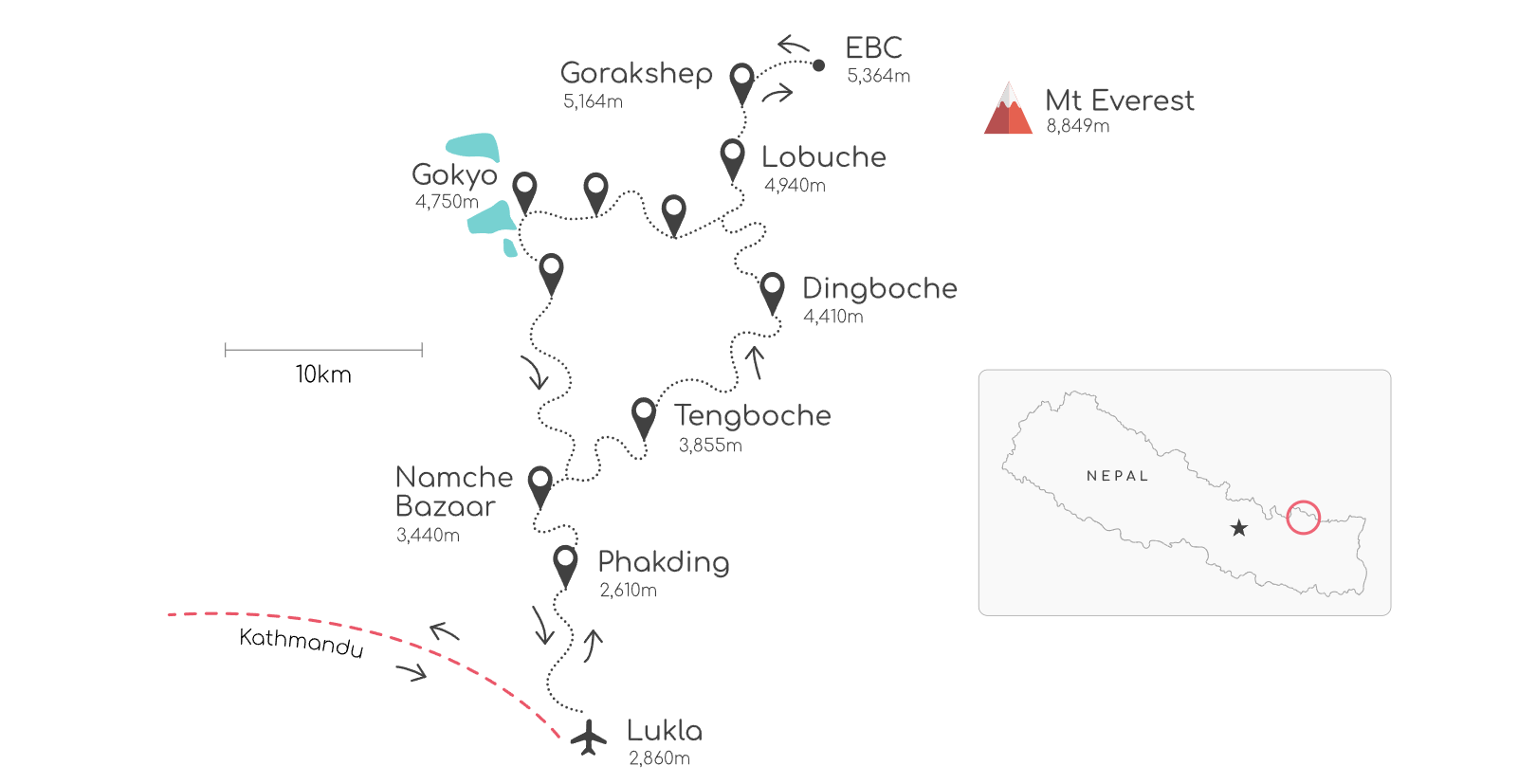
Frequently Asked Questions (FAQ)
The luxury trek focuses on enhancing comfort, service quality, and the overall experience. It includes higher-end accommodations, a diverse menu, scenic helicopter flights, and more.
The trek is open to individuals and groups seeking a more upscale and comfortable trekking experience. It is accessible to both seasoned adventurers and those without prior high-altitude trekking experience.
The itinerary is thoughtfully paced, including ample rest and acclimatization days. It begins with a warm welcome in Kathmandu, cultural exploration, and a scenic flight to Lukla, followed by a carefully planned trekking route with Helicopter return back to Kathmandu.
Accommodations include upscale hotels in Kathmandu and luxury lodges along the trek. The trek also involves a night in a semi-luxury lodge and comfortable lodges, offering a blend of luxury and adventur in the remote places during the trek
Safety is a top priority, with an experienced leadeo, expert guides equipped with a supplementary oxygen system, and a comprehensive medical kit. The trek is designed for acclimatization and well-being.
The trek reaches a maximum elevation of Kalapathar at 5,500m and includes a night in Gorekshep at 5,140m. The journey spans 13 days, gradually guiding participants to higher altitudes.
Meals are included, featuring a wider variety of menu options catering to different tastes and dietary preferences. High-quality, well-prepared food is a key component of the luxury experience.
Yes, the Luxury Everest Base Camp Trek is designed to be accessible to everyone, including those without prior high-altitude trekking experience. Safety measures and acclimatization days are incorporated for a smooth experience.
Yes, the trek concludes with a unique helicopter ride from Gorekshep back to Kathmandu, providing a swift return and a 360-degree bird’s-eye view of the diverse Nepalese terrain.
Himalayan Trekking and Tours, established since 2003, offers a wealth of experience, long-term operation of the trek, experienced guides, a friendly Sherpa team, luxury accommodations, tailored itineraries, stringent safety measures, cultural experiences, and positive reviews, reflecting a commitment to exceptional service and unforgettable experiences.
Luxury treks include scenic helicopter flight, adding a touch of exclusivity and providing breathtaking aerial views of the Everest region.
Forget the hassles of organizing logistics; we take care of your ground transfers, trekking permits, and airfare, ensuring a seamless and comfortable experience
The luxury trek includes a wider variety of menu options, catering to different tastes and dietary preferences, ensuring high-quality, well-prepared food.Please let us know prior your dietary concerns so we can address it promptly for your trekking in Nepal.
The Luxury Everest Base Camp Trek is open to both individuals and groups seeking a more upscale and comfortable trekking experience.
- Instant Confirmation
- Free to customize
- Support anytime
© 2025 - Himalayan Trekking and Tours (P) Ltd. All Rights Reserved.
